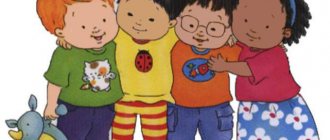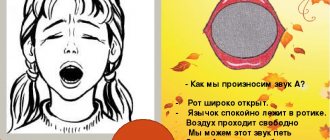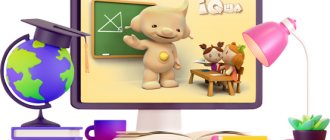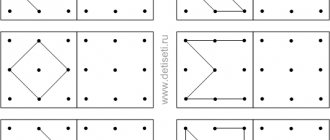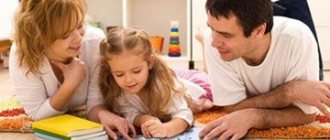Bibliography
1. Varentsova N.S. Some problems of a teacher's work on the development of mental abilities in preschool children. - In the book. Educational work in kindergarten under the “Development” program. Methodological manual for preschool teachers / Ed. Dyachenko O. M., Kholmovskoy V. V., -M.: Gnom i D, 2001.
2. Varentsova N.S. Continuity in the education of children of preschool and primary school age // Preschooler. Junior schoolboy, 2003 - No. 4.
3. Questions of psychology of educational activities of junior schoolchildren / Ed. D. B. Elkonina, V. V. Davydova. -M.: APN RSFSR, 1962.
4. Preparing the hand for writing // Preschool education, 1996, No. 2.
5. Diploma for preschoolers. - In the book. Children, get ready for school - M.: Education, 2008.
6. Durova N.V., Nevskaya L.N. Teaching preschoolers literacy. Didactic materials in four books, - Part 4 (We read it ourselves). - M.: School press, 2001.
7. Zhurova L.E. Teaching literacy in kindergarten. -M.: Education, 1974.
8. Getting to know the “Development” program: A manual for educators and parents / Ed. O. M. Dyachenko. -M.: New School, 1997.
9. Pedagogical diagnostics according to the “Development” program. Recommendations and materials for implementation. Junior and middle preschool age, -M.: Gnom-Press, 1999.
10. Pedagogical diagnostics according to the “Development” program. Recommendations and materials for implementation. Senior preschool age, - M.: Gnom-Press, 1999.
11. Lesson plans for the “Development” program for the younger group of kindergarten. – UC named after. L.A. Wenger "Development". -M., 2000.
12. Lesson plans for the “Development” program for the younger group of kindergarten. – UC named after. L.A. Wenger "Development". -M., 2000.
13. Lesson plans for the “Development” program for the preparatory group of kindergarten. – UC named after. L.A. Wenger "Development". -M., 2000.
14. Lesson plans for the “Development” program for the middle group of kindergarten, – UC named after. L.A. Wenger “Development”, M., 2000.
15. Lesson plans for the “Development” program for the senior group of kindergarten. – UC named after. L. A. Wenger “Development”. -M., 2000.
16. Preparation for teaching literacy in kindergarten / Ed. N.S. Varentsova, N.S. Starzhinskaya. – Minsk: Nar. Asveta, 1992.
17. Preparation for teaching literacy to five-year-old children. Guidelines. – Minsk: MP of the BSSR, 1986.
18. Speech development. - In the book. Diary of a teacher: development of preschool children / Ed. O. M. Dyachenko, T. V. Lavrentieva. Vol. 1, 2, -M.: Series “Psychology of Education”, MOiPK, 1996.
19. Development: New generation program for preschool educational institutions. Junior group / Ed. O. M. Dyachenko.-M.: Gnom-Press, 1999.
20. Development: New generation program for preschool educational institutions. Middle group / Ed. O. M. Dyachenko.-M.: Gnom-Press, 1999.
21. Development: New generation program for preschool educational institutions. Senior group / Ed. O. M. Dyachenko.-M.: Gnom-Press, 1999.
22. Development: New generation program for preschool educational institutions. Preparatory group / Ed. O. M. Dyachenko, M.: Gnom-Press, 1999.
23. Rogovin A. I want to do it myself, - M.: Pedagogy, 1984.
24. Fedosova N. A. Getting ready to write. – Part 1, 2, -M.: Gnom i D, 2004.
25. Reading and writing according to the system of D. B. Elkonin. Book for teachers, M.: Education, 1993.
26. Shuleshko E.E. Teaching writing and reading. Methodological manual for kindergarten teachers. – M., 1998.
27. Elkonin D.B. How to teach children to read. Abstract information. Preschool education. -M., 1977, -No. 4.
Summary of OOD on teaching literacy and speech development in the senior group of preschool educational institutions
Summary of organized educational activities for teaching literacy “Let's Help the Sun.”
Educational area: “Speech development” Age: children 5 - 6 years old Purpose: To develop the ability to conduct sound analysis of a word, distinguish between vowels, consonants, hard and soft sounds, divide words into syllables, teach children to correctly pronounce the sound [L] in various forms of speech activities. Objectives: Educational:
To form the correct articulatory pattern of pronunciation of vowel sounds.
Strengthen the ability to differentiate sounds: vowels and consonants, hard and soft consonants. Teach analysis and synthesis of the word “lemon”. Strengthen the connection between the sound image and the visual (graphic) one, improve the skills of sound-syllable analysis and synthesis. Improve the skill of dividing words into syllables. Developmental:
Develop speech motor skills, phonemic perception and phonemic analysis.
Develop phonemic awareness. Develop auditory memory and attention. Form visual perception, spatial orientation, fine motor skills. Educational:
To foster independence, control over one’s own speech.
Cultivate interest in the activity through the use of entertaining exercises. Cultivate purposefulness and curiosity. Equipment: gloves for articulation gymnastics, illustrations (cat, whale, pear, lemon, hippopotamus, rhinoceros), palette with rainbow colors. Methodological techniques: verbal, visual, problem-based - search.
Progress of activities:
— Guys, look how many guests you have in kindergarten today.
Let's say hello to them. Hello! And today I came to visit your kindergarten to make friends with you. And to get to know each other better, I propose to assemble a pyramid from our palms. My name is Olga Ivanovna (extends her palm). Whoever says their name next (children take turns saying their names) say their names and put our palms on top of each other. What a wonderful pyramid it turned out to be from our friendly palms. We will always be friends, We will cherish friendship. With friendship there is no fear of bad weather. Friendship is only happiness! - Oh, guys, you hear these strange sounds. What do you think this is? (children's answers). I wonder who it was who didn’t get enough sleep today. Maybe you, Masha. Or you, Dasha. Oh, look (the yawning sun appears). - Oh, so the sun didn’t get enough sleep. Dear sunshine, you’ve been sleeping for a long time today, it’s time to wake up. Sunny: I was walking in the blue sky, and I lost my sound [L]. I am no longer the sun, my name is Sonyshko. Now I sleep all day, I don’t give warmth to people. Find the sound faster, return the sun to the sky. Then I will shine in the blue sky again. - Guys, you see what a disaster happened, the sound [L] in the word sun was lost. - What is sound (sound is what we hear and pronounce). - How does it differ from a letter? - Where will we look for the sound [L]. - And I suggest we go to Zvukograd. But which children will travel with me? - Maybe sad (no, cheerful). - We will take with us not cowardly children, but which ones? (brave, courageous). - Not lazy, but what kind? (hardworking). - Or maybe evil children will set off on their journey? (no, kind ones). “And the sunbeams will help us find our way to Zvukograd.” We take each other’s hands tightly and set off (to the music “Sunny Bunnies” the children walk holding hands). - So we got to the city of Zvukograd, and we found ourselves on the street where vowel sounds live. What do you know about vowel sounds? (vowel sounds are sung, they can be sung like a song; when we pronounce them, the air does not meet an obstacle, neither lips, nor teeth, nor tongue interfere with us). - And vowel sounds have a favorite song. I suggest you sing it with the help of magic gloves. We put the glove on our right hand, these are our assistants who will help us sing the song. Did you all manage? These are the funny helpers we have today. - So, the sound [A], what happens when we pronounce the sound [A] (our mouth opens wide). And the assistant hand will show how wide the mouth opens, like A-A-A. - And when we pronounce the sound [U], what happens to our lips? (they are pulled out into a small tube). An assistant hand will show how they stretch out O-U-U-U, that’s how. - And when we pronounce the sound [O], our lips (round). How can a hand show? O-O-O-O. - And when we pronounce the sound [I] (lips smile, stretch into a smile). A helping hand will show how the lips stretch into a smile. - And now I invite you to listen to the song of vowel sounds. The music “Speech therapy chants” sounds.
“Now let’s sing it together, you can use this hint.”
- Who is the bravest and will try to sing the song on their own? - Well done, how well you sing! Guys, do you think we can find the lost sound [L] on the street of vowel sounds? Why can't we find this sound here? (because he is a consonant) Then I suggest going to the street of consonants. Hold hands tightly and go (children walk hand in hand to the music “Sunny Bunnies”). - Here we are on the street of consonant sounds . Let's remember everything we know about consonant sounds (consonant sounds are hard and soft, we denote hard sounds in blue, and soft sounds in green). A new house was built on Consonant Street. All the residents have gathered, but they can’t figure out who will live in which apartment. Let's help them settle. Sit as you please. What do you think the blue and green colors of the windows mean? We will move into these apartments residents whose names have a hard consonant as the first sound. “And here we will settle residents whose first sound is a soft consonant.” We will place residents whose names have 1 syllable on the first floor, those with 2 syllables in their names on the second floor, and 3 syllables on the third floor (the children explain “moving in”). — Is there a missing sound [L] at the beginning of all these words? (no) You are probably tired, let's rest a little, let's play with the sunbeams, take each other's hands and walk in a circle. Fizkul
Oh, guys, look, one of the residents of the house wants to help us find the missing sound [L], let's listen to what he tells us.
Lemon: I'll tell you where to look for the sound, But first you help me. And a diagram for the name lemon. Hurry up, guys. Well, guys, I think we can handle the scheme too! Go to the table. (Analysis of schemes, selection of schemes that fit the word lemon). Guys, we found the diagram correctly, and now I think that the lemon will tell us where to find the missing sound [L]. Lemon: To find your brother, you need to go to the river. There's an arc beyond the river, and it's called a rainbow. Find my paint in it, find what’s missing in it. And here is the river, and what a beautiful rainbow there is above it. Let's get closer to her. Guys, how can we find the sound [L] in a rainbow? (problem situation). Perhaps the sound [L] is hidden in the names of the colors of the rainbow. Let's check it out. We will name all the colors of the rainbow and try to find the color in which the sound [L] is hidden. There is a sound [L] in two colors of the rainbow. Maybe we can take both colors? No, we only need one color. Do you remember what the lemon said? He asked to find the same color as his. What color is the lemon? That's right, yellow, so we only take yellow paint. Look, the rainbow has prepared all its colors for us, choose the one we need and set off on the way back. Hold each other's hands tightly. (Walk to the music) - Dear sun, accept your loss. Now you are the sun again! Shine brighter! Sunny: Oh, thank you guys, I’m so glad, I’m so glad. I will shine cheerfully and warm you, kids. - Guys, let's tell the sun where we were and what interesting things we saw. (Children's answers) And because you are so friendly, so kind and smart, the sun gives you his cheerful rays of sunshine as a gift, may they please you and remind you of our interesting journey. See you again, guys!
We recommend watching:
Summary of a lesson in the middle group on the works of Marshak Notes of the GCD in the middle group “Help the Cockerel” Summary of the GCD in the middle group on the topic: “Who lives in the little house?” Summary of a design lesson in the middle group "Tumbler"
Similar articles:
Math lesson “Rectangle” in the middle group of kindergarten
Benefits of classes:
- These classes will enable the child to better acquire knowledge about the variety of sounds and letters;
- will form ideas about words and that words consist of sounds;
- will be a good assistant in the formation of phonemic hearing (the ability to hear and distinguish sounds in speech);
- With the help of adults, children will learn to distinguish sounds in speech, and therefore pronounce them correctly.
- Completing these tasks will help prepare children for learning to read and write in the senior group of kindergarten and in preparation for school.
Each lesson is located on 2 sheets of A4 format. You can print on two sheets, or on one - a page on each side. Total, 50 sheets - 50 full-fledged lessons on developing the pronunciation side of speech and teaching literacy.
The classes are developed based on our website. On the site you will find colorful illustrations, games and exercises to help with the printouts.
Instructions included.
Each lesson contains detailed instructions on how to complete the tasks. Tasks include: a description of the sound being studied, a graphic representation of a letter, a copy of letters, many illustrations of sounds and other interesting material.
In order for the child to find it both interesting and useful at the same time, the classes are supplemented with numerous coloring books . This is both visibility for the child and the development of fine motor skills of the fingers . Let us remind you that it is better to color with triangular pencils: they fit better in the child’s fingers.
